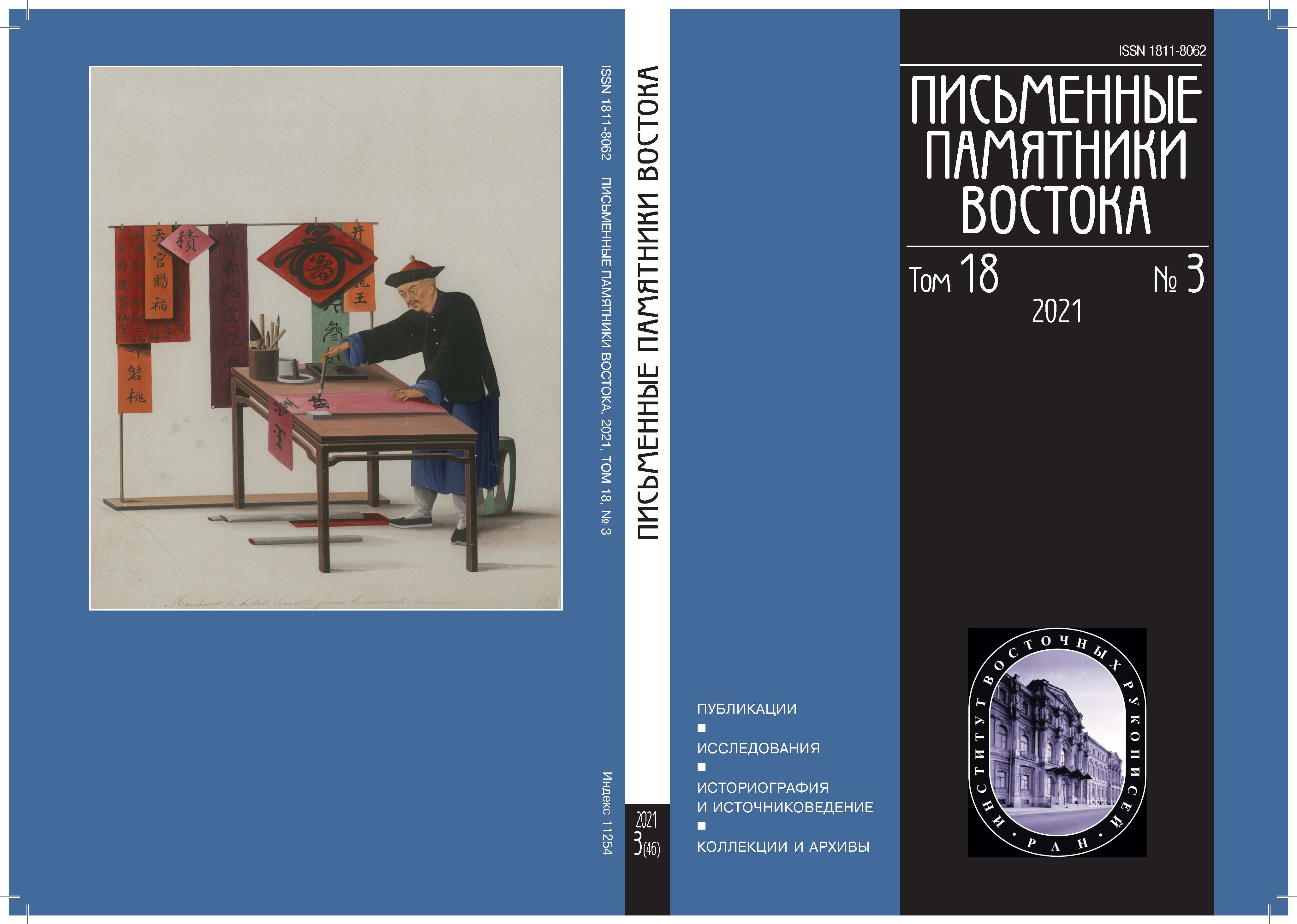О тангутском префиксе 2da:-
- Авторы: Аракава С.1
-
Учреждения:
- Токийский университет, Исследовательский институт языков и культур Азии и Африки
- Выпуск: Том 18, № 3 (2021)
- Страницы: 64-73
- Раздел: Исследования
- Статья опубликована: 28.12.2021
- URL: https://journals.eco-vector.com/1811-8062/article/view/77306
- DOI: https://doi.org/10.17816/WMO77306
- ID: 77306
Цитировать
Полный текст
Аннотация
На тангутском языке говорили при династии Сися (1038-1227) в северо-западной части Китая, а тангутский шрифт был изобретен при первом императоре (1036 г.). Несмотря на то, что и тангутский язык и письменность уже вышли из употребления, тем не менее благодаря наличию большого количества письменных источников мы можем реконструировать фонологию и грамматику этого языка. Тангутский язык принадлежит к тибето-бирманской языковой группе (тангут-цян). В его грамматике сохранились уникальные особенности, которых нет ни в старо-тибетском, ни в старо-бирманском языках. Один из них – «префикс направления». В тангутском языке существует шесть или семь морфем, которые используются как префиксы. В предыдущих работах мы разбирали случаи перехода функции префикса от «направительного» к «аспектному (перфектному)». В некоторых малочисленных тибето-бирманских языках есть морфемы по звучанию и функциям схожие с тангутскими. В данной статье на различных примерах разбирается префикс 2da:- и рассматриваются особенности его употребления.
Ключевые слова
Об авторах
Синтаро Аракава
Токийский университет, Исследовательский институт языков и культур Азии и Африки
Автор, ответственный за переписку.
Email: arakawa@aa.tufs.ac.jp
доцент
Япония, ТокиоСписок литературы
- Arakawa, Shintaro (荒川慎太郎). 「ロシア所蔵西夏語訳『般若心経註』の研究 [Study on the Tangut version of “Prajñāpāramitā-Hṛdaya Sūtra with a commentary” preserved in Russia] 中央アジア古文献の言語学的・文献学的研究 (Contribution to the Studies of Eurasian Languages Series 10) (白井聡子・庄垣内正弘編),京都大学文学部言語学研究室, 2006, pp. 95–156 (+図版8 (in Japanese).
- Arakawa, Shintaro. プリンストン大学所蔵西夏文華厳経巻七十七訳注 [An annotated Japanese Translation of the Tagut Version of Avatamsaka Sūtra, vol. 77 in Princeton University Collection] アジア・アフリカ言語文化研究 [Journal of Asian and African Studies], 2011, vol. 81, pp. 147–305 (in Japanese).
- Arakawa, Shintaro. “On the Tangut Verb Prefixes in ‘Tiansheng Code’. Tangury v Tsentralnoi Azii: Sbornik statei v chest 80-letiia prof. E.I. Kychanova”. Moscow: Vostochaia literatura, 2012, pp. 58–71 (in English).
- Arakawa, Shintaro. “On the Tangut verb phrase in The Sea of Meaning, Established by the Saints.” Central Asiatic Journal, 2014a, vol. 57, pp. 15–25 (in English).
- Arakawa, Shintaro. 西夏文金剛経の研究 [Studies on the Tangut version of the Vajracchedikā-prajñāpāramitā] 京都:松香堂, 2014b (in Japanese).
- Arakawa, Shintaro. プリンストン大学図書館所蔵西夏文妙法蓮華経 ―写真版及びテキストの研究 [Tangut Version of the Lotus Sutra in the Collection of the Princeton University Library: Facsimile, Text and Linguistic Studies] 東京・創価学会・東洋哲学研究所, 2018 (in Japanese).
- Gong, Hwang-Cherng. Tangut. G. Thurgood and R. J. LaPolla (eds.) The Sino-Tibetan languages. London: Routledge, 2003, pp. 602–620 (in English).
- Kepping Kseniya B. “Kategoriia vida v tangutskom uizyke” [A Category of Aspect in Tangut]. Narody Azii i Afriki, 1968, no. 3, pp. 134–139 (in Russian).
- Kepping Kseniya B. “A category of aspect in Tangut. (transl. with coments E. Grinstead)”. Acta Orientalia, 1971, vol. XXXIII, pp. 283–294 (in English).
- Kepping Kseniya B. Sun stzy v tangutskom perevode [Sun-zi in Tangut]. Moscow: Nauka, 1979 (in Russian).
- Kepping Kseniya B. Deictic motion verbs in Tangut. (translated by K. Rumsey and S. DeLancy). Linguistics of the Tibeto-Burman Area, 1982 , vol. 6, no. 2, pp. 77–82 (in English).
- Kepping Kseniya B. Les tategorii — utracheyyaia kitaiskaia lei-lin v tangutskom perevode [LEI-LIN in Tangut]. Moscow: Nauka, 1983 (in Russian).
- Kepping Kseniya B. — Tangutskii iazyk. Morfologiia [Tangut. Mophorogy]. Moscow: Nauka, 1985 (in Russian).
- Kepping Kseniya B. “The conjugation of the Tangut verb”. Bulletin of the School of Oriental and African Studies, 1994a, vol. LVII, part 2, pp. 339–346 (in English).
- Kepping Kseniya B. “The category of directedness of action in Tangut”. St. Petersburg Jornal of Oriental Studies, 1994b, vol. 5, pp. 267–291 (in English).
- Kychanov Evgenii I., Arakawa Shintaro. Slovar tangutskogo (Si Sia) iazyka: tangutsko-Russko-Kitaiskii slovar [Dictionary of the Tangut Lanquage: Tangut-Russian-English-Chinese Dictionary]. Kyoto: Faculty of Letters, Kyoto University, 2006 (in Russian).
- Li, Fanwen (李 範文) ed. 《同音研究 [A Study of Tongyin]》,寧夏人民出版社,銀川, 1986 (in Chinese).
- Li, Fanwen — 《夏漢字典 [Tangut Dictionary]》 北京:中国社会科学出版社 (増補修正本 2008), 1997 (in Chinese).
- Lin, Yingchin (林 英津). 孫子兵法西夏訳本中所見動詞詞頭的語法功能 [The grammatical function of verbal prefixes in a Tangut translation of Sun-tzu Ping-fa]. 《中央研究院歴史語言研究所集刊 [Bulletin of the Institute of History and Philology Academia Sinica]》, 1987, vol. 58.2, pp. 381–445 (in Chinese).
- Lin, Yingchin. 西夏語具有空間意義的語詞. 《中央研究院歴史語言研究所集刊 [Bulletin of the Institute of History and Philology Academia Sinica]》, 1993, vol. 62, pp. 677–716 (in Chi¬nese).
- Lin, Yingchin. 《夏訳《孫子兵法》研究 [Research on SUN-TZY PING-FA in Tangut]》. 上下(中央研究院歴史語言研究所単巻之二十八 [Institute of History and Philology Academia Sinica Monographs, no. 28]. 台北:中央研究院歴史語言研究所, 1994 (in Chinese).
- Nevsky, Nikolai A. Tangunskaia filologiia. V 2 kn. [Tangut Filology]. Moscow: Vostochnaia literatura, 1960 (in Russian).
- Nishida, Tatsuo (西田龍雄). 西夏語の研究-西夏語の再構成と西夏文字の解読 [Study of Tangut Language] I, 座右宝刊行会, 1964 (in Japanese).
- Nishida, Tatsuo. 西夏語 [Tangut]. 言語学大辞典 第2巻 世界言語編(中) [The Sanseido encyclopaedia of linguistics, vol. 2]. (亀井孝他 (T. Kamei et al.) 編).東京:三省堂 [Sanseidō], 1989a, pp. 408–429 (in Japanese).
- Nishida, Tatsuo. チベット・ビルマ語派 [Tibeto-Burman]. 言語学大辞典 第2巻 世界言語編(中)
- [The Sanseido encyclopaedia of linguistics, vol. 2] (亀井孝他 (T. Kamei et al.) 編).東京:三省堂 [Sanseidō], 1989b, pp. 791–822 (in Japanese).
- Nishida, Tatsuo, 西夏文字 [Tangut Script]. 言語学大辞典 別巻 世界文字辞典 [The Sanseido Encyclopaedia of Linguistics, Script and Writing System of the World] (河野六郎他 (R. Kono et al.) 編).東京:三省堂 [Sanseidō], 2001, pp. 537–547 (in Japanese).
- Sofronov Mikhail V. Grammatika tamgutskogo iazyka [Tangut Grammar]. 1. Moscow: Nauka, 1968 (in Russian).
Дополнительные файлы








